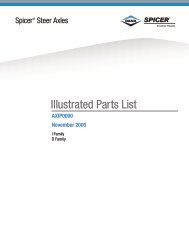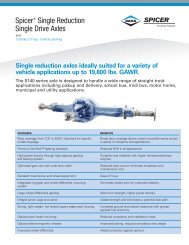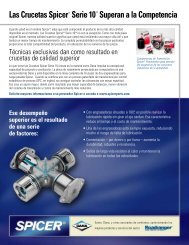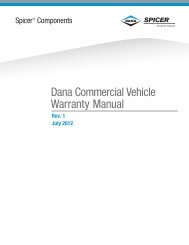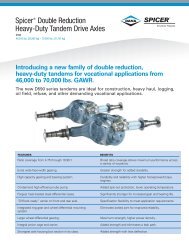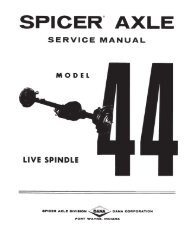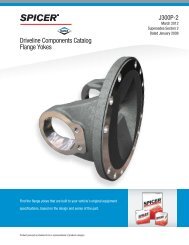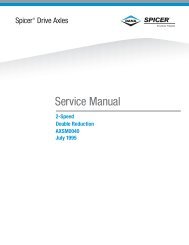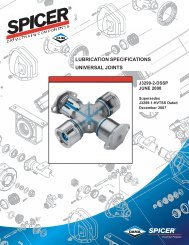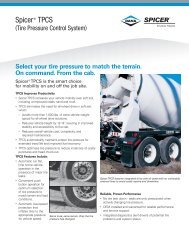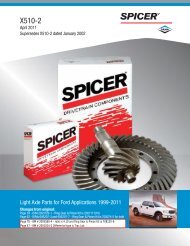Service Manual - Dana Corporation
Service Manual - Dana Corporation
Service Manual - Dana Corporation
Create successful ePaper yourself
Turn your PDF publications into a flip-book with our unique Google optimized e-Paper software.
Adjustments<br />
Adjust Pinion Bearing Preload for Axles with<br />
"Slip-fit" Outer Pinion Bearings<br />
1. Lubricate bearings and assemble the drive pinion, bearings, and<br />
pinion bearing cage as recommended in the assembly section of this<br />
manual (Page 25). Use the pinion bearing spacer removed from the axle<br />
during disassembly. If the original spacer cannot be used, install the<br />
nominal spacer recommended in the adjacent chart.<br />
NOTE: Bearing spacer washer is not used on 13, 15, 16, 17, 18, 21, 22<br />
Series axles.<br />
2. Apply clamp load to the pinion bearings. Install the yoke and torque the<br />
nut to specification or use a press to simulate nut torque by applying<br />
pressure to the assembly (see chart below).<br />
Vise Method - If the yoke and nut are used, mount the assembly in a vise,<br />
clamping yoke firmly.<br />
Press Method - If a press is used, position a sleeve or spacer so that<br />
load is applied directly to the back-face of outer pinion bearing.<br />
3. Measure Pinion Bearing Preload - Use a spring scale to test the<br />
assembly rolling torque. To use the spring scale, wrap a soft wire around<br />
the bearing cage, attach the scale and pull. Preload is correct when<br />
torque required to rotate the pinion bearing cage is from 15 to 35 inch<br />
pounds. This specification is translated into spring scale readings in the<br />
chart below.<br />
4. Adjust Pinion Bearing Preload - If necessary, adjust pinion bearing<br />
preload. Disassemble the pinion bearing cage as recommended in this<br />
manual and change the pinion bearing spacer. A thicker spacer will<br />
decrease preload. A thinner spacer will increase preload.<br />
IMPORTANT: Use the correctly sized spacer. Do not use shim stock or<br />
grind spacers. These practices can lead to loss of bearing preload and<br />
gear or bearing failure.<br />
Measuring Bearing Preload with Measuring Bearing Preload with<br />
Pinion in Vise. Pinion in Press.<br />
Specifications for Pinion<br />
Bearing Preload Test<br />
("Slip-fit" Ou ter<br />
Pinion Bearings)<br />
Nut Torque Press Loads<br />
Axle Series Ft-lbs. N.m T o n s Metric Tons<br />
13/15/16* 360-440 488-596 12-13 11-12<br />
17*/18+<br />
480-600 650-813 14-15 13-14<br />
17*/18/19/20/21/22Ê 560-700 759-949 14-15 13-14<br />
19/20/23*/26/30ˆ 840-1020 1139-1383 19-20 17-18<br />
+1 1/4-12 Pinion Nut Ê1 1/2-18 Pinion Nut ˆ1 3/4-12 Pinion Nut, *15130 & 16130 Models only use metric nut<br />
M30 X 1.5, 17130 models use metric nut M36 X 1,5,23130 models use metric nut M42 X 1.5<br />
Nominal Pinion<br />
Bearing Spacers<br />
Spacer Thickness<br />
Axle Model in. mm<br />
13/15 . . . . . . . . . . . . . . . 0.528 13 .41<br />
16 . . . . . . . . . . . . . . . . . 0.638 16 .21<br />
17/18/21/22 . . . . . . . . 0.638 16.21<br />
19/20/23/26/30 . . . . . . . . 0.185 4.70<br />
Spring Scale Reading<br />
(without pinion seal)<br />
(for 15-35 m-lbs. torque)<br />
(1.7-4 N.m)<br />
Ib.s<br />
7-16<br />
6-14<br />
6-13<br />
5-12<br />
k S.<br />
3.2-7.3<br />
2.7-6.4<br />
2.7-5.9<br />
2.3-5.4<br />
15



